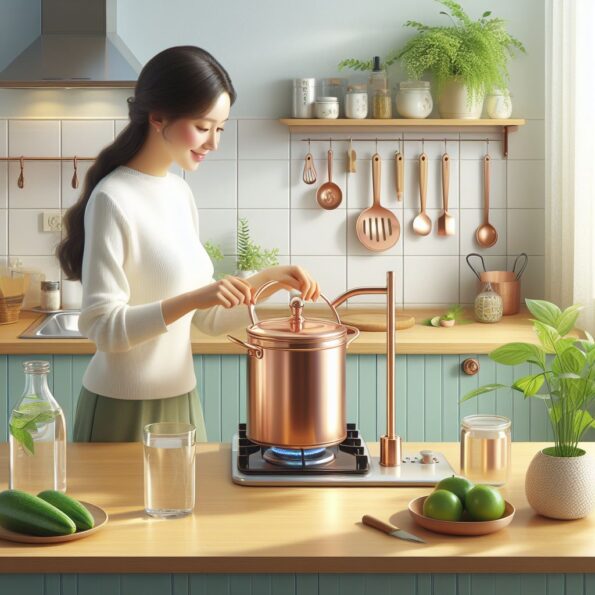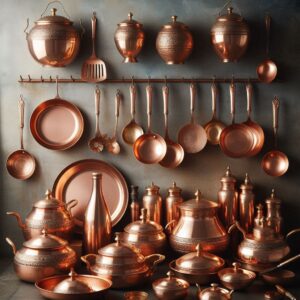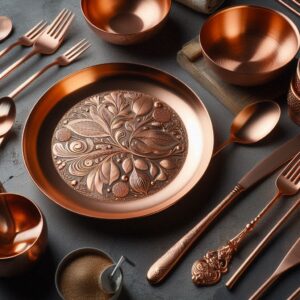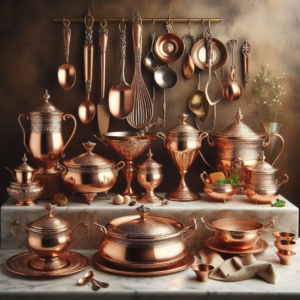In our quest for eco-friendly kitchen practices, copper indeed holds a significant key to unlocking a greener kitchen. Its unparalleled heat conductivity ensures energy-efficient cooking, while its natural antibacterial properties contribute to a healthier kitchen environment. Whether through copper water bottles or cookware, this material not only adds aesthetic value but also brings functional benefits. When choosing copper products, look for authentic, high-quality items to ensure you’re getting the most sustainable and healthful options available.
Switching to copper can transform your kitchen into a green kitchen. Copper’s durability and recyclability make it an eco-friendly choice for various kitchen items. Using copper water bottles, cookware, and utensils helps reduce plastic waste and supports sustainable living.
Copper water bottles are an excellent alternative to single-use plastics. They are long-lasting, which means less waste and fewer resources needed for replacements. Copper is also 100% recyclable, ensuring minimal environmental impact. This makes copper water storage a sustainable choice.
Copper’s antibacterial properties also make it ideal for kitchen use. It naturally kills bacteria, reducing the need for chemical cleaners. This keeps your kitchen clean and safe while minimizing harmful chemical usage.
Cooking with copper cookware offers energy efficiency. Copper heats up quickly and evenly, reducing cooking times and energy consumption. This not only saves you money but also reduces your carbon footprint.
Investing in the best copper water bottles and cookware supports a green kitchen. By choosing sustainable materials, you contribute to a healthier planet. Copper’s long-lasting nature and recyclability make it an excellent choice for eco-conscious households.
The Historical Significance of Copper in the Kitchen
Copper has a rich history in cookware and kitchen design, valued for its superior heat conductivity and aesthetic appeal. Traditionally, copper was used for its ability to conduct heat evenly, making it ideal for tasks that required precise temperature control, such as caramelizing sugar or simmering sauces. Its durability also meant that it could last for generations, often becoming more beautiful over time as it developed a patina. Over time, the design of copper cookware has evolved to meet modern needs while maintaining its classic appeal. Today, most copper cookware is lined with stainless steel to prevent reactions with acidic foods, combining the best of old and new technologies.
Traditional Uses: Traditionally, copper was used for its ability to conduct heat evenly, making it ideal for tasks that required precise temperature control, such as caramelizing sugar or simmering sauces. Its durability also meant that it could last for generations, often becoming more beautiful over time as it developed a patina.
Evolution of Copper Kitchenware: Over time, the design of copper cookware has evolved to meet modern needs while maintaining its classic appeal. Today, most copper cookware is lined with stainless steel to prevent reactions with acidic foods, combining the best of old and new technologies. The timeless presence of copper in the kitchen continues as it adapts to contemporary culinary practices, offering both functionality and beauty.
Copper’s enduring presence in the Greener Kitchen is a testament to its versatility and the ongoing appreciation for its unique properties and contribution to the culinary arts. Whether in traditional settings or modern designs, copper remains a sustainable and cherished choice for eco-friendly kitchen practices.
Copper’s Role in a Sustainable Kitchen
Copper plays a crucial role in creating a sustainable kitchen, thanks to its excellent recyclability and contribution to a circular economy. It’s a material that aligns perfectly with the principles of sustainability:
Recyclability and Circular Economy: Copper is 100% recyclable and retains its properties indefinitely, making it a staple in the circular economy. Every year, millions of tonnes of copper are recycled and reintroduced into various uses, reducing the need for new raw material extraction. This process supports a sustainable future by minimizing waste and maximizing resource efficiency.
Energy Efficiency: In terms of cookware, copper’s superior thermal conductivity means it heats up quickly and distributes heat evenly, reducing the energy required for cooking. This efficiency translates to less energy consumption and lower utility bills, making copper cookware a choice that benefits both the environment and the consumer.
By choosing copper for your kitchen, you’re not only opting for a material with timeless appeal and excellent cooking performance but also contributing to a more sustainable world. Copper’s role in eco-friendly practices extends beyond the kitchen, as it’s essential in renewable energy technologies and other green innovations that are key to a sustainable future.
Health and Cooking Benefits of Copper
Copper offers several health and cooking benefits, making it a valuable addition to a green kitchen. Using copper water bottles and cookware can enhance both your culinary experience and overall well-being. Copper is known for its antibacterial properties, which help keep your kitchen hygienic. Storing water in a copper water bottle can purify the water and boost your immune system.
Copper is renowned for its superior heat conductivity, which is essential for even cooking. With a thermal conductivity value of 385 W/(m·K), copper is twice as conductive as aluminum, the leading metal in cookware. This high conductivity allows copper pots and pans to heat up quickly and distribute heat evenly, ensuring that food is cooked uniformly and efficiently.
In addition to its thermal benefits, copper boasts natural antibacterial properties. Copper surfaces can kill a wide range of harmful microbes, including bacteria, viruses, and fungi. The metal releases copper ions upon contact with these microorganisms, which disrupt their cell membranes and DNA, effectively destroying them. This antimicrobial action is enhanced by the generation of reactive oxygen species (ROS), which cause oxidative damage to the pathogens.
Cooking with copper pots and pans ensures even heat distribution, reducing cooking times and energy consumption. This energy efficiency supports a more sustainable kitchen. Additionally, copper cookware’s durability means it lasts longer, reducing the need for frequent replacements and minimizing waste.
Health benefits of copper water bottles extend beyond the kitchen. Drinking water from pure copper bottles can improve digestion and promote healthy skin. The antibacterial properties of copper can also help reduce the risk of infections.
Investing in the best copper water bottles and cookware is a smart choice for those looking to create a green kitchen. Copper’s natural properties and sustainability make it an eco-friendly option that benefits both health and the environment.

How to Identify Genuine Copper Products
Identifying genuine copper products is important for ensuring you’re investing in quality items that offer the sustainability and longevity copper is known for. Here are some tips to help you distinguish authentic copper items:
Tips for Distinguishing Authentic Copper Items:
- Look for Markings: Genuine copper often has markings indicating its origin or manufacturer.
- Test the Weight: Copper is denser and heavier than many other metals.
- Check for Patina: Authentic copper develops a green patina over time due to oxidation.
- Color Test: Real copper has a reddish-brown hue that may darken over time.
- Magnet Test: Copper is not magnetic, so if a magnet sticks, it’s likely not pure copper.
- Sound Test: When struck, copper should emit a clear, ringing sound.
- Density Check: The density of copper is 8.96 grams per cm³, which can be tested by measuring weight and volume.
Importance of Quality in Copper Products: Quality in copper products is crucial for their longevity and sustainability. High-quality copper items last longer, reducing the need for frequent replacements and thus contributing to a circular economy. Quality copper is also more likely to be recyclable, maintaining its value and functionality through multiple life cycles. Investing in quality copper products supports sustainable practices and ensures that the benefits of copper, such as its thermal conductivity and antibacterial properties, are fully realized over the product’s lifespan.
Copper Alternatives and Complements
When considering eco-friendly materials for a greener kitchen, copper is just one of many sustainable options.
Here are some alternatives and complements to copper that can help create an environmentally friendly cooking space:
Eco-Friendly Materials:
- Bamboo: A rapidly growing, renewable resource that makes excellent kitchenware and countertops.
- Recycled Glass: Utilized for countertops and dishware, it’s durable and has a unique aesthetic.
- Stainless Steel: Recyclable and long-lasting, it’s a practical choice for various kitchen items.
- Reclaimed Wood: Adds warmth and character to the kitchen while being sustainable.
- Paper Composite: An innovative material for countertops made from post-consumer paper waste.
Integrating Copper with Other Sustainable Kitchenware: Copper can be beautifully integrated with other eco-friendly materials to create a cohesive and sustainable kitchen design. For instance:
- Pair copper pans with bamboo utensils for a mix of modern and natural elements.
- Use copper light fixtures above a recycled glass countertop for an elegant touch.
- Combine copper sinks with stainless steel appliances for a harmonious metallic theme.
- Accentuate a reclaimed wood table with a copper centerpiece to blend rustic charm with sophistication.
By mixing copper with other sustainable materials, you can enjoy the benefits of each while contributing to a more eco-friendly kitchen environment. Remember, the key to a sustainable kitchen is not just the materials you choose, but also how you use and care for them to ensure they last for years to come.
Conclusion
In conclusion, copper can indeed be the key to a greener kitchen. From reducing plastic waste to improving energy efficiency, copper offers numerous environmental benefits. Consider incorporating copper water bottles and cookware into your kitchen to make a positive impact on the environment.
Copper indeed holds a significant key to unlocking a greener kitchen. Its unparalleled heat conductivity ensures energy-efficient cooking, while its natural antibacterial properties contribute to a healthier kitchen environment. The recyclability of copper aligns with the principles of a circular economy, emphasizing its role in sustainable living.
However, the journey to a truly eco-friendly kitchen doesn’t end with copper. It’s about integrating a variety of sustainable materials and practices, from bamboo utensils to energy-saving appliances. Copper, with its timeless appeal and functional benefits, can be a central element in this diverse mix, complementing other eco-friendly choices.
Ultimately, a greener kitchen is about making conscious decisions that reduce our environmental impact, improve our health, and enhance our culinary experience. Copper, with its myriad of benefits, is a valuable ally in this endeavor, helping us to create spaces that are not only aesthetically pleasing but also kind to our planet. So, while copper may not be the sole answer, it is certainly a substantial part of the solution towards more sustainable kitchen practices.











